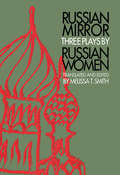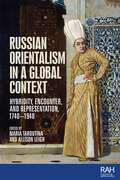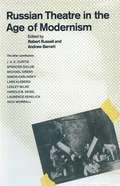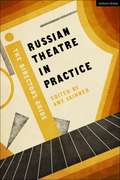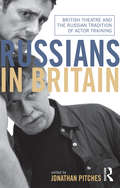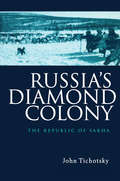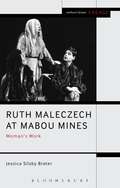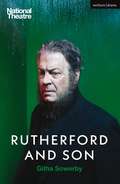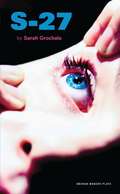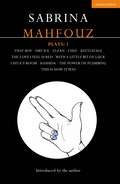- Table View
- List View
Russian Mirror: Three Plays by Russian Women
by Melissa T. SmithThe three playwrights presented together in this volume On the Road to Ourselves), Elena Gremina (Behind the Mirror) and Olga Mikhailova (Russian Dream). The selected plays contain many elements which will appeal to Western directors and audiences: well-drawn characters, engaging plots, lively wit. Central to the three plays selected in this volume is a complex interaction of Russian and Western value systems, a theme that becomes increasingly relevant for Russian audiences with each passing season and no less relevant for Europeans and Americans.
Russian Orientalism in a global context: Hybridity, encounter, and representation, 1740–1940 (Rethinking Art's Histories)
by Maria Taroutina and Allison LeighThis volume features new research on Russia’s historic relationship with Asia and the ways it was mediated and represented in the fine, decorative and performing arts and architecture from the mid-eighteenth century to the first two decades of Soviet rule. It interrogates how Russia’s perception of its position on the periphery of the west and its simultaneous self-consciousness as a colonial power shaped its artistic, cultural and national identity as a heterogenous, multi-ethnic empire. It also explores the extent to which cultural practitioners participated in the discursive matrices that advanced Russia’s colonial machinery on the one hand and critiqued and challenged it on the other, especially in territories that were themselves on the fault lines between the east and the west.
Russian Orientalism in a global context: Hybridity, encounter, and representation, 1740–1940 (Rethinking Art's Histories)
by Maria Taroutina Allison LeighThis volume features new research on Russia’s historic relationship with Asia and the ways it was mediated and represented in the fine, decorative and performing arts and architecture from the mid-eighteenth century to the first two decades of Soviet rule. It interrogates how Russia’s perception of its position on the periphery of the west and its simultaneous self-consciousness as a colonial power shaped its artistic, cultural and national identity as a heterogenous, multi-ethnic empire. It also explores the extent to which cultural practitioners participated in the discursive matrices that advanced Russia’s colonial machinery on the one hand and critiqued and challenged it on the other, especially in territories that were themselves on the fault lines between the east and the west.
Russian Realisms: Literature and Painting, 1840–1890 (NIU Series in Slavic, East European, and Eurasian Studies)
by Molly BrunsonOne fall evening in 1880, Russian painter Ilya Repin welcomed an unexpected visitor to his home: Lev Tolstoy. The renowned realists talked for hours, and Tolstoy turned his critical eye to the sketches in Repin's studio. Tolstoy's criticisms would later prompt Repin to reflect on the question of creative expression and conclude that the path to artistic truth is relative, dependent on the mode and medium of representation. In this original study, Molly Brunson traces many such paths that converged to form the tradition of nineteenth-century Russian realism, a tradition that spanned almost half a century—from the youthful projects of the Natural School and the critical realism of the age of reform to the mature masterpieces of Tolstoy, Fyodor Dostoevsky, and the paintings of the Wanderers, Repin chief among them. By examining the classics of the tradition, Brunson explores the emergence of multiple realisms from the gaps, disruptions, and doubts that accompany the self-conscious project of representing reality. These manifestations of realism are united not by how they look or what they describe, but by their shared awareness of the fraught yet critical task of representation. By tracing the engagement of literature and painting with aesthetic debates on the sister arts, Brunson argues for a conceptualization of realism that transcends artistic media. Russian Realisms integrates the lesser-known tradition of Russian painting with the familiar masterpieces of Russia's great novelists, highlighting both the common ground in their struggles for artistic realism and their cultural autonomy and legitimacy. This erudite study will appeal to scholars interested in Russian literature and art, comparative literature, art history, and nineteenth-century realist movements.
Russian Theatre in Practice: The Director's Guide (Performance Books)
by Amy SkinnerAmidst the turmoil of political revolution, the stage directors of twentieth-century Russia rewrote the rules of theatre making. From realism to the avant-garde, politics to postmodernism, and revolution to repression, these practitioners shaped perceptions of theatre direction across the world. This edited volume introduces students and practitioners alike to the innovations of Russia's directors, from Konstantin Stanislavsky and Vsevolod Meyerhold to Anatoly Efros, Oleg Efremov and Genrietta Ianovskaia. Strongly practical in its approach, Russian Theatre in Practice: The Director's Guide equips readers with an understanding of the varying approaches of each director, as well as the opportunity to participate and explore their ideas in practice. The full range of the director's role is covered, including work on text, rehearsal technique, space and proxemics, audience theory and characterization. Each chapter focuses on one director, exploring their historical context, and combining an examination of their directing theory and technique with practical exercises for use in classroom or rehearsal settings. Through their ground-breaking ideas and techniques, Russia's directors still demand our attention, and in this volume they come to life as a powerful resource for today's theatre makers.
Russian Theatre in Practice: The Director's Guide (Performance Books)
by Amy SkinnerAmidst the turmoil of political revolution, the stage directors of twentieth-century Russia rewrote the rules of theatre making. From realism to the avant-garde, politics to postmodernism, and revolution to repression, these practitioners shaped perceptions of theatre direction across the world. This edited volume introduces students and practitioners alike to the innovations of Russia's directors, from Konstantin Stanislavsky and Vsevolod Meyerhold to Anatoly Efros, Oleg Efremov and Genrietta Ianovskaia. Strongly practical in its approach, Russian Theatre in Practice: The Director's Guide equips readers with an understanding of the varying approaches of each director, as well as the opportunity to participate and explore their ideas in practice. The full range of the director's role is covered, including work on text, rehearsal technique, space and proxemics, audience theory and characterization. Each chapter focuses on one director, exploring their historical context, and combining an examination of their directing theory and technique with practical exercises for use in classroom or rehearsal settings. Through their ground-breaking ideas and techniques, Russia's directors still demand our attention, and in this volume they come to life as a powerful resource for today's theatre makers.
The Russian Urban Sustainability Puzzle: How Can Russian Cities be Green? (Emerald Points)
by Polina Ermolaeva Yulia Ermolaeva Olga Basheva Irina Kuznetsova Valerya KorunovaThis book provides a comprehensive analysis of the socio-environmental issues and sustainability challenges facing Russian cities. It encompasses a three-year project in Moscow and Kazan which includes population surveys, mass-media analysis, and interviews with different groups of stakeholders. The authors offer extensive analysis of the main components of sustainable cities such as air and water quality, sustainable transport and mobility, energy efficiency and energy consumption, waste management, green and blue zones, environmental governance and politics. The conclusion provides critical reflections on how understandings of Russia's sustainability challenges can be used to build more tailored and effective environmental governance for its cities.
The Russian Urban Sustainability Puzzle: How Can Russian Cities be Green? (Emerald Points)
by Polina Ermolaeva Yulia Ermolaeva Olga Basheva Irina Kuznetsova Valerya KorunovaThis book provides a comprehensive analysis of the socio-environmental issues and sustainability challenges facing Russian cities. It encompasses a three-year project in Moscow and Kazan which includes population surveys, mass-media analysis, and interviews with different groups of stakeholders. The authors offer extensive analysis of the main components of sustainable cities such as air and water quality, sustainable transport and mobility, energy efficiency and energy consumption, waste management, green and blue zones, environmental governance and politics. The conclusion provides critical reflections on how understandings of Russia's sustainability challenges can be used to build more tailored and effective environmental governance for its cities.
Russians in Britain: British Theatre and the Russian Tradition of Actor Training
by Jonathan PitchesFrom Komisarjevsky in the 1920s, to Cheek by Jowl’s Russian ‘sister company’ almost a century later, Russian actor training has had a unique influence on modern British theatre. Russians in Britain, edited by Jonathan Pitches, is the first work of its type to identify a relationship between both countries’ theatrical traditions as continuous as it is complex. Unravelling new strands of transmission and translation linking the great Russian émigré practitioners to the second and third generation artists who responded to their ideas, Russians in Britain takes in: Komisarjevsky and the British theatre establishment. Stanislavsky in the British conservatoire. Meyerhold in the academy. Michael Chekhov in the private studio. Littlewood’s Theatre Workshop and the Northern Stage Ensemble. Katie Mitchell, Declan Donnellan and Michael Boyd. Charting a hitherto untold story with historical and contemporary implications, these nine essays present a compelling alternative history of theatrical practice in the UK.
Russians in Britain: British Theatre and the Russian Tradition of Actor Training
by Jonathan PitchesFrom Komisarjevsky in the 1920s, to Cheek by Jowl’s Russian ‘sister company’ almost a century later, Russian actor training has had a unique influence on modern British theatre. Russians in Britain, edited by Jonathan Pitches, is the first work of its type to identify a relationship between both countries’ theatrical traditions as continuous as it is complex. Unravelling new strands of transmission and translation linking the great Russian émigré practitioners to the second and third generation artists who responded to their ideas, Russians in Britain takes in: Komisarjevsky and the British theatre establishment. Stanislavsky in the British conservatoire. Meyerhold in the academy. Michael Chekhov in the private studio. Littlewood’s Theatre Workshop and the Northern Stage Ensemble. Katie Mitchell, Declan Donnellan and Michael Boyd. Charting a hitherto untold story with historical and contemporary implications, these nine essays present a compelling alternative history of theatrical practice in the UK.
Russia's Diamond Colony: The Republic of Sakha
by John TichotskyFirst Published in 2000. Routledge is an imprint of Taylor & Francis, an informa company.
Russia's Diamond Colony: The Republic of Sakha
by John TichotskyFirst Published in 2000. Routledge is an imprint of Taylor & Francis, an informa company.
Ruth Maleczech at Mabou Mines: Woman's Work (Methuen Drama Engage)
by Jessica Silsby Brater Enoch Brater Mark Taylor-BattyConstituting the first comprehensive look at Ruth Maleczech's work, Jessica Brater's companion is a landmark study in innovative theatre practice, bringing together biography, critical analysis, and original interviews to establish a portrait of this Obie-award winning theatre artist. Tracing Maleczech's background, training, and influences, the volume contextualizes her work and the founding of Mabou Mines within the wider landscape of American avant-garde theatre. It considers her performances and productions, revealing both her interest in making ordinary women important onstage, and her predilection for resurrecting extraordinary women from history and finding their resonances within a contemporary theatrical context. Brater considers Maleczech's investment in redrawing the boundaries of what women are allowed to say, both on stage and off, and shows how her commitment to radical artistic and production risks has reshaped the contours of a contemporary theatrical experience. Highlights of the volume include discussion of productions such as Mabou Mines' Lear, Dead End Kids, Hajj, Lucia's Chapters of Coming Forth by Day, Red Beads, and La Divina Caricatura, as well as a close look at Maleczech's final work-in-progress, Imagining the Imaginary Invalid.
Ruth Maleczech at Mabou Mines: Woman's Work (Methuen Drama Engage)
by Jessica Silsby Brater Prof. Enoch Brater Mark Taylor-BattyConstituting the first comprehensive look at Ruth Maleczech's work, Jessica Brater's companion is a landmark study in innovative theatre practice, bringing together biography, critical analysis, and original interviews to establish a portrait of this Obie-award winning theatre artist. Tracing Maleczech's background, training, and influences, the volume contextualizes her work and the founding of Mabou Mines within the wider landscape of American avant-garde theatre. It considers her performances and productions, revealing both her interest in making ordinary women important onstage, and her predilection for resurrecting extraordinary women from history and finding their resonances within a contemporary theatrical context. Brater considers Maleczech's investment in redrawing the boundaries of what women are allowed to say, both on stage and off, and shows how her commitment to radical artistic and production risks has reshaped the contours of a contemporary theatrical experience. Highlights of the volume include discussion of productions such as Mabou Mines' Lear, Dead End Kids, Hajj, Lucia's Chapters of Coming Forth by Day, Red Beads, and La Divina Caricatura, as well as a close look at Maleczech's final work-in-progress, Imagining the Imaginary Invalid.
Ruth Page: The Woman in the Work
by Joellen A. MeglinIn Ruth Page: The Woman in the Work, the Chicago ballerina emerges as a highly original choreographer who, in her art, sought the iconoclastic as she transgressed boundaries of genre, gender, race, class, and sexuality. Author Joellen A. Meglin shows how her works were often controversial and sometimes censored even as she succeeded in roles usually reserved for men in the ballet world: choreographer, artistic director, and impresario. From extensive dramaturgical analysis of her most famous ballets L La Guiablesse, Frankie and Johnny, Billy Sunday, Revenge, The Merry Widow, Camille, Carmina Burana, and Alice L to embodied re-imagining of an avant-garde solo performed in a "sack" designed by Isamu Noguchi, this biography follows the global reach of Ruth Page's career spanning the greater part of the twentieth century. In the process of discovering the woman in the work, one encounters with an international cast of dancers (Anna Pavlova, Harald Kreutzberg, Frederic Franklin, Alicia Markova), composers (William Grant Still, Aaron Copland, Jerome Moross, Darius Milhaud), visual artists (Noguchi, Pavel Tchelitchew, Antoni Clavé), and companies (Ballet Russe de Monte Carlo, Ballets des Champs-Elysées, London Festival Ballet). Disrupting notions that New York was the only cradle of the American ballet, and George Balanchine, its exponent to eclipse all others, Ruth Page explores the woman's unique sensibility, corporeal praxis, and collaborative ethos to reveal her Chicago-centered network of creativity.
Ruth Page: The Woman in the Work
by Joellen A. MeglinIn Ruth Page: The Woman in the Work, the Chicago ballerina emerges as a highly original choreographer who, in her art, sought the iconoclastic as she transgressed boundaries of genre, gender, race, class, and sexuality. Author Joellen A. Meglin shows how her works were often controversial and sometimes censored even as she succeeded in roles usually reserved for men in the ballet world: choreographer, artistic director, and impresario. From extensive dramaturgical analysis of her most famous ballets L La Guiablesse, Frankie and Johnny, Billy Sunday, Revenge, The Merry Widow, Camille, Carmina Burana, and Alice L to embodied re-imagining of an avant-garde solo performed in a "sack" designed by Isamu Noguchi, this biography follows the global reach of Ruth Page's career spanning the greater part of the twentieth century. In the process of discovering the woman in the work, one encounters with an international cast of dancers (Anna Pavlova, Harald Kreutzberg, Frederic Franklin, Alicia Markova), composers (William Grant Still, Aaron Copland, Jerome Moross, Darius Milhaud), visual artists (Noguchi, Pavel Tchelitchew, Antoni Clavé), and companies (Ballet Russe de Monte Carlo, Ballets des Champs-Elysées, London Festival Ballet). Disrupting notions that New York was the only cradle of the American ballet, and George Balanchine, its exponent to eclipse all others, Ruth Page explores the woman's unique sensibility, corporeal praxis, and collaborative ethos to reveal her Chicago-centered network of creativity.
Rutherford and Son (Modern Plays)
by Githa SowerbyNo one's any right to be what father is - never questioned, never answered back...First staged in 1912 and described as "the most powerful play produced in England in this decade," Githa Sowerby's Edwardian classic on family and labour enjoyed huge success in London and New York before disappearing from view. In a Northern industrial town, John Rutherford rules both factory and family with an iron will. But even as the furnaces burn relentlessly at the Glassworks, at home his children begin to turn against him.Sowerby's astonishing play was inspired by her own experience of growing up in a family-run factory in Gateshead. Writing in 1912, when female voices were seldom heard on British stages, she now claims her place alongside Ibsen and Bernard Shaw with this searing depiction of class, gender and generational warfare.This new edition was published to coincide with the National Theatre's revival in May 2019.
Rutherford and Son: A Play In Three Acts... - Primary Source Edition (Modern Plays)
by Githa SowerbyNo one's any right to be what father is - never questioned, never answered back...First staged in 1912 and described as "the most powerful play produced in England in this decade," Githa Sowerby's Edwardian classic on family and labour enjoyed huge success in London and New York before disappearing from view. In a Northern industrial town, John Rutherford rules both factory and family with an iron will. But even as the furnaces burn relentlessly at the Glassworks, at home his children begin to turn against him.Sowerby's astonishing play was inspired by her own experience of growing up in a family-run factory in Gateshead. Writing in 1912, when female voices were seldom heard on British stages, she now claims her place alongside Ibsen and Bernard Shaw with this searing depiction of class, gender and generational warfare.This new edition was published to coincide with the National Theatre's revival in May 2019.
S-27 (Oberon Modern Plays)
by Sarah GrochalaMay is an idealist. She’s fighting for a better world and has sacrificed more than most. So when the old regime is destroyed, she is rewarded with a job as a prison photographer.But as the enemy pass one by one before her unflinching lens - both strange and familiar faces - can they shake her belief in this world she helped to create?Inspired by the work of the photographer Nhem En, who photographed the inmates of the Tuol Sleng prison in Cambodia under the rule of the Khmer Rouge, and by painter Van Nath who painted Pol Pot and was one of the only seven survivors of Tuol Sleng, playwright Sarah Grochala draws on prison records and interviews with both prisoners and Khmer Rouge cadres to create a startling and affecting drama.S-27 won the first Protect The Human Playwriting Competition in 2007, run by iceandfire in conjunction with Amnesty International and Soho Theatre, and was in production at the Finborough Theatre in June 2009.
Sabotage Art: Politics and Iconoclasm in Contemporary Latin America (International Library of Modern and Contemporary Art #20160331)
by Sophie Halart Mara Polgovsky EzcurraSabotage is the deliberate disruption of a dominant system, be it political, military or economic. Yet in recent decades, sabotage has also become an artistic strategy – most notably in Latin America. In Brazil, Colombia, Mexico, Chile and Argentina, artists are producing radical, unruly or even iconoclastic work that resists state violence, social conformity and the commodification of art. Sabotage Art reveals how contemporary Latin American artists have resorted to 'sabotage' strategies as a means to bridge the gap between aesthetics and politics. The global status of – and market for - Latin American art is growing rapidly. This book is essential reading for those who want to understand this new, dissident work, as well as its mystification, co-option and commercialisation within current academic historiographies and art-world curatorial initiatives.
Sabrina Mahfouz Plays: That Boy; Dry Ice; Clean; Chef; Battleface; The Love I Feel is Red; With a Little Bit of Luck; Layla's Room; Rashida; Power of Plumbing; This is How it Was (Contemporary Dramatists)
by Sabrina MahfouzSabrina Mahfouz has been called 'theatrical dynamite' by The Independent and '[one of] our most interesting playwrights' by Lyn Gardner in The Guardian. As a recent elected Fellow of the Royal Society of Literature, she is a playwright, poet, essayist, children's author and activist whose work explores a variety of mediums in challenging and genre-defying ways. Her first play collection brings together a unique mix of published and previously unpublished works for the stage, including a Off West End Award-winning play for children; a Fringe First award-winner; a BBC Radio & Music Best Drama award-winner and a Sky Arts Academy award-winning play. From the explosive poetic monologue play Chef to the rhythmic drive of With a Little Bit of Luck, this collection fizzes with infectious lyricism that captures Mahfouz's work for the stage in a variety of different forms, proving that contemporary theatre remains boundless in terms of its ability to spark debate and move audiences.
Sabrina Mahfouz Plays: That Boy; Dry Ice; Clean; Chef; Battleface; The Love I Feel is Red; With a Little Bit of Luck; Layla's Room; Rashida; Power of Plumbing; This is How it Was (Contemporary Dramatists)
by Sabrina MahfouzSabrina Mahfouz has been called 'theatrical dynamite' by The Independent and '[one of] our most interesting playwrights' by Lyn Gardner in The Guardian. As a recent elected Fellow of the Royal Society of Literature, she is a playwright, poet, essayist, children's author and activist whose work explores a variety of mediums in challenging and genre-defying ways. Her first play collection brings together a unique mix of published and previously unpublished works for the stage, including a Off West End Award-winning play for children; a Fringe First award-winner; a BBC Radio & Music Best Drama award-winner and a Sky Arts Academy award-winning play. From the explosive poetic monologue play Chef to the rhythmic drive of With a Little Bit of Luck, this collection fizzes with infectious lyricism that captures Mahfouz's work for the stage in a variety of different forms, proving that contemporary theatre remains boundless in terms of its ability to spark debate and move audiences.
Sabu
by Michael LawrenceThe first Indian to become an international film star, Sabu rose to fame as a child actor in Elephant Boy (1937), and subsequently appeared in a succession of British pictures before relocating to Hollywood, where he died in 1963. Repeatedly cast in orientalist extravaganzas and jungle thrillers, he was associated with the 'exotic' and the 'primitive' in ways that reflected contemporary attitudes towards India and 'the East' more generally. In this captivating study, Michael Lawrence explores the historical, political, cultural contexts of Sabu's popularity as a star, and considers the technological and industrial shifts that shaped his career – from the emergence of Technicolor in the late 1930s to the breakdown of the studio system in the 1950s. Attending to the detail of Sabu's distinctively physical performances, Lawrence shows how his agency as an actor enabled him to endure, exceed and exploit his unique star image.
The Sack of Rome, 1527 (The A. W. Mellon Lectures in the Fine Arts #26)
by André ChastelFrom a leading art historian of Renaissance Italy, a compelling account of the artistic and cultural impact of the sack of sixteenth-century RomeIn this illustrated account of the sack of Rome as a cultural and artistic phenomenon, André Chastel reveals the historical ambiguities of preceding events and the traumatic contrast between the flourishing world of art under Pope Clement VII and the city after it was looted by the troops of Emperor Charles V in 1527. Chastel illuminates the cultural repercussions of the humiliation of Rome, emphasizing the spread or “Europeanization” of the Mannerist style by artists who fled the city—including Parmigianino, Rosso, Polidoro, Peruzzi, and Perino del Vaga. At the same time, Clement’s critics used the new media of printing and engraving to win over the people with caricatures and satirical writings, while Rome responded with monumental works affirming the legitimacy of the pope’s temporal power. Chastel explores both the world that was lost by the sack and the great works of art created during Rome’s recovery.
